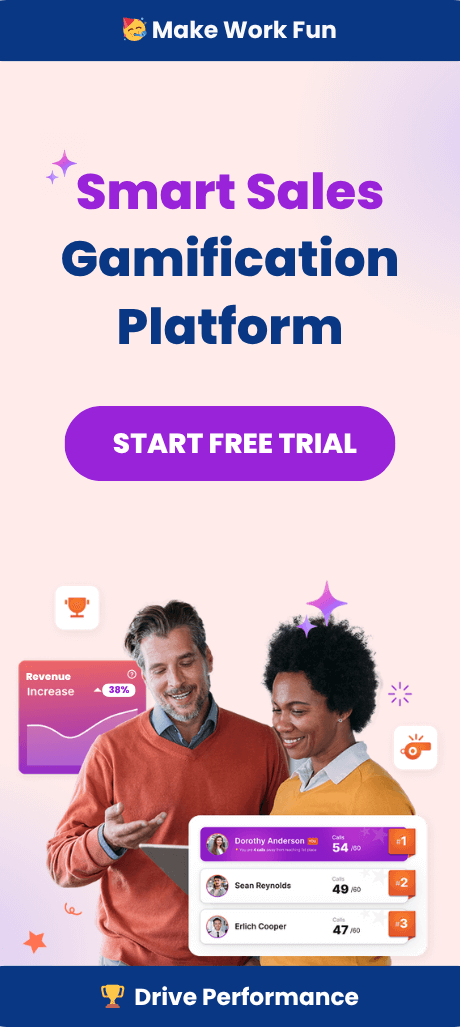When onboarding large numbers of staff and doing so regularly, getting everyone up to speed and bringing in revenue as quickly as possible is important. Any innovations in training methods within sales departments are therefore welcome. Fortunately, there are surefire ways to improve the process of sales training using Gamification.
What is Gamification?
Gamification is using game mechanics to increase engagement and improve skills retention. By game mechanics, we mean gameplay features, including challenges, quizzes, points, badges, rewards, and often a competitive leaderboard.
These game mechanics will be familiar to salespeople, particularly interpersonal competitive components like leaderboards. Others will be less well-known. They all contribute to making your in-house sales team training more appealing and successful.
How Successful is Gamification in Training?

Whether onboarding new employees or training existing workers in specific workplace skills,
Gamification is a popular tool for improving learning retention. Here are some statistics:
- 33% of employees want to see training gamified (more than any other work function).
- In education generally, for example, game-based learning improves student performance by over 34%.
- After implementing gamified sales training, software company Autodesk saved a 15% rise in conversions.
- Coffee giant Kenco saw a 45% rise in bottom-line sales margin after developing a gamified sales tool.
As you can see, it can be extremely lucrative to start using Gamification in staff training, especially in your sales team. Let’s look more closely at the business advantages of doing so, then run through some best practice principles and examples.
Four Reasons to Use Gamification for Sales Training
1: Game mechanics promote healthy competition.
Sales teams thrive on healthy competition within, both interpersonal and individual. Leaderboards are already a fact of life in sales offices, with sales reps competing for the highest conversions and the most revenue achieved.
Therefore, encouraging reps and sales leaders to see learning and passing course quizzes as competitive is a soft sell. Gamification, in terms of competition and rewards, is already a language that reps speak, in other words.
2: Gamification improves knowledge retention.
The software review platform Technology Advice puts it very well: “Gamification increases engagement by providing incentives for learners to pay attention and complete tasks. The added reward, even intangible, can encourage better listening and observation. When the learner is focused, they are more likely to absorb the information presented.”
Holding your audience’s attention during a classroom training session can be challenging, as anyone ever held a training session after lunch on a Friday will testify. Using online platforms that incentivize attention because they promise a reward for completion gives you a head start.
3: Gamification encourages excellence in training.
By using fun quizzes and interactive games, Gamification breaks down knowledge into smaller components that can be consumed by the participant when they can better focus. This means that each learner is likelier to perform better during training sessions and see each course through to completion.
It’s also possible to directly link each module to practical examples and engaging video content which bring home the reality of the lessons learned. When trainees can see the applicability of each lesson to the job they’re about to do, they’re more engaged and interested.
4: Gamification is value for money and captures KPIs.
It’s highly cost-effective to do onboarding through e-learning platforms rather than running endless in-person sessions. While it’s true that it’s good to have some in-person training, much of a job’s detailed and routine aspects can be explained more effectively (and cost-effectively) online.
Better yet, many gamification systems record engagement and the obvious productivity metrics of completions, pass scores, and quiz results. It’s possible to directly measure the effectiveness of your training materials and modify them to optimize results.
Next, try some tips and tricks to make Gamification in sales training more effective.
6 Tips for Better Gamification in Sales Training
Create Simulations and Case Studies
To bring home the real-world applications of a skill, it’s a great idea to use both real case studies and simulated situations, which allow the next salesperson or rep to test their mettle.
Case studies can be especially effective when video interviews are incorporated. Reps can see an experienced peer talking about a challenge they’ve faced, then relate this to their own experiences.
Simulations allow a game-based approach to learning. First, set up a tricky scenario, such as a recalcitrant prospect or a difficult question, and then present various options for dealing with the problem. Let the learner choose one option and demonstrate how it would play out.
With a simulation, the lesson plays out like an interactive game. Trainees can play all options and learn how various approaches would work or fail.
Give Rewards for Module Completion

Rather than rely solely upon the desire to achieve a high pass score, trainers can create a rewards program that incentivizes excellent performance and skill acquisition. From badges and points, which leverage competitiveness, to tokens exchanged for gifts and services, rewards programs can be great motivators.
Provide Instant Feedback
By their very nature, games provide immediate feedback on how players are doing. We can learn a valuable lesson from this: people like to know whether their training is on track. Keeping this a mystery until the end of a module isn’t helpful.
Therefore, as well as the progress bars showing users how close they are to completion, you can incorporate points scores for mid-module quizzes, encouraging participants to revise learning and aim to improve. Don’t wait until the end of a black of training to assess how well learners are doing; instead, adopt a continuous learning and assessment model and display scores.
Let participants re-do quizzes to achieve a better mark is also important. Setting a high pass mark for courses (like 80%) can be advantageous to encourage more revision and knowledge retention.
Break Learning into Modules
A modular approach works best because it allows learners to focus on specific course units and maintain attention. Various studies have shown that humans can focus intensely on a topic for short periods. However, the ideal study time has been estimated at between 15 and 45 minutes without requiring a break or change of activity.
Err on caution and aim to do each module last 10-20 minutes. Try to keep the course as brief as possible, and you will reduce frustration and improve participant scores.
Get Interactive in Information Delivery
Rather than displaying endless blocks of text and bullet points, well-designed gamified online learning reveals information in various ways. For instance, a question might be posed, and possible answers displayed. When the user moves their cursor over each answer, some analysis is provided for each possibility.
Many gamification platforms allow information to be displayed in response to user behavioral triggers like clicks, highlighting, circling, or hovering over screen sections. Because this involves active participation, it keeps attention levels higher than when less user participation is required.
Keep it Fun
This may seem like a no-brainer, but it bears repeating. If you can make the learning process fun while still covering all your mandatory topics, employees will be less avoidant and keener to participate.
By incorporating mini-games and fun quizzes, you can reduce the commonplace belief that mandatory workplace training is boring. Just as video training companies learned to use comedy to communicate their message, Gamification uses interactivity to make it more active, returning agency to the participant.
Sales Training and Psychology: How Does Gamification Work?
It’s worth looking a little deeper before you choose a gamification platform. It’s commonly held that a game-based approach leverages participants’ psychological and even physiological processes. Let’s look at how those mechanisms work, which will help us select an appropriate degree and type of Gamification for our training.
CRM platform HubSpot summarized the mechanism thus: “Popularized by B.F. Skinner, the model says that the consequences of a behavior determine the likelihood of it being repeated. Behaviors that receive positive reinforcement, like rewards or praise, are most often repeated.”
This fits with our common sense understanding. We want to repeat activities we find rewarding and which we enjoy. Therefore, if we cannot see the purpose or benefits of a training course and don’t experience any reward for taking part, we’ll view it as an imposition.
B. F. Skinner, incidentally, was an American psychologist specializing in behavioral psychology. He talked about the learning experience as a form of conditioning, in which stimuli are presented and rewards or punishments are given to condition how learners respond to those stimuli.
Modern thinking has moved away from a punishment-based model of learning reinforcement. We focus more on the carrot than the stick, in other words!
What are the rewards of sales training gamification?
A host of rewards can be offered to training participants. These include:
- The pleasure of achieving a high leaderboard score in terms of success in both points and completion metrics.
- Badges or other visual markers of completion, which participants can retain in a training record, and which can contribute to continuing professional development.
- Shout-outs from leadership and colleagues for course completion, certification, or achieving especially high scores.
- The status of achieving certification and progressing to a new level of professional accreditation may convey new duties and responsibilities.
- Tokens or points can be exchanged for goods and services alongside points earned in the sales professionals’ day-to-day duties.
All these reward options can contribute to the boost learners feel when they complete a module or course.
Now let’s consider some good practice examples of sales gamification across various industries.
3 Examples of Good Practice in Sales Training Gamification
Cisco Systems
The communications company created three tiers for its social media training program: specialist, strategist, and master. This mirrored the experience levels many games use to keep players engaged over multiple sessions.
Each tier came with its certification and increasing completion requirements, including a sample blog post and case study for the higher levels. There were also four sub-specialisms, allowing more participants to demonstrate focused expertise. This leveraged the sense of achievement that people experience when they learn a special skill.
Team projects were introduced, with badges earned for team challenges and objectives, helping to build team cohesion while building skills.
Salesforce
The CMS giant has an LMS called Trailhead, a virtual map of courses that users can complete to earn certification and career progression.
Videos and interactive activities are incorporated into the various courses that Salesforce users can take, improving engagement. Effectively, platform users become certified advocates and help sell the organization and product through word of mouth.
McDonald’s
Sales training in retail must be optimized to the maximum; there’s no time to waste. Fast-food giant Mcdonald’s found that a game-based simulated environment was a good way to have sales managers get till operators up to speed.
Their learning platform included game mechanics like lifelines (to gain clues and tips) and badges for recognition of task achievement. Simulated real-time customer conversations allowed trainees to try out their customer service skills. Performance metrics were delivered, which could be used by both trainees and management and sales leaders alike to monitor progress.
These are just three contrasting examples out of the millions of companies now using Gamification to motivate sales staff to learn essential skills.
Gamification Sweetens the Pill of Mandatory Training
Many sales teams have discovered that the most effective way to onboard new reps and get them up to speed is to use a gamification strategy for training.
Spinify has created tools to deliver highly optimized gamified training environments. Why not book a free personalized demo today?



